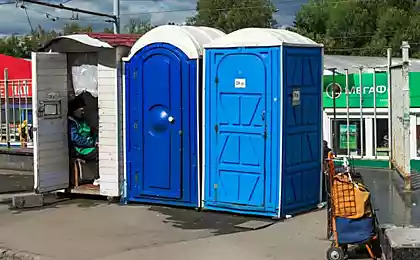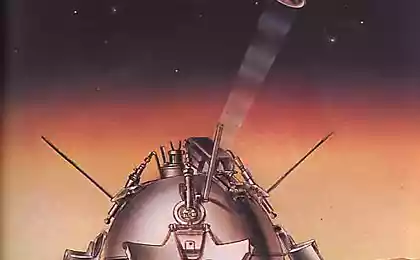1415
The history of space toilet
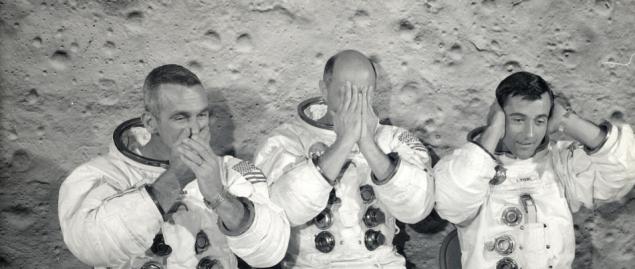
One day in your house begins overhaul of water and wastewater systems. Workers remove the old risers water supply and sanitation, and for a few days you get a little astronaut - wiping wipes instead of a shower, drinking containers, technical and technological waste water Cesspool capacity with the smell of bleach and other inconveniences. Fortunately, more than half a century of the history of spaceflight stores enough stories to distract and lift the mood. In fact, any repairs pales before the inconveniences endured by, for example, Frank Borman and Jim Lovell on the "Gemini-VII».
The imperfection of human h4> The first toilet problems have appeared at the beginning of spaceflight. May 5, 1961. Astronaut Alan Shepard has become the first American in space. According to the plan suborbital flight should last only fifteen minutes, so none of the engineers did not think about human needs. However, due to problems with the weather and technology start was delayed, and in some point, Alan, had spent in the cockpit for more than four hours (and in the suit more than eight), said on the radio that it is imperative to go to urinate. Before TsUPom arose very real problem - trying to help in the suit could lead to failure of the sensor telemetry problems with thermoregulation system suit, in the worst (though unlikely) case - in a short circuit. An alternative would only cancel the flight - to submit service tower for a few minutes, go to the bathroom and come back to the cabin, there was no technical possibility. And, considering the public launch, imagine the headlines if the flight was canceled for this reason. Decided to take a risk - Shepard allowed to relieve themselves in glamorous shiny suit. The accident did not happen, and the countdown continued. To the credit of Alan Shepard, he reacted to the situation with humor and joked that now he is a "wet back" (slang designation of illegal Mexican migrants swam across the Rio Grande). The flight was successful, but still during playback торжественной meeting on the aircraft carrier bit funny to know that the back-then Shepard wet ...
On the second American astronaut Gus Grissom put two-layer tights that urine contained between the layers. The decision was unsuccessful, and already the first orbital flight of John Glenn was developed simple urinal (UCD - Urine Collection Device) from pre * ervativa, tubes and containers for urine:

By the last flight of the ship "Mercury" system changed a bit. Urinal on a spacesuit complement fixed capacity. Astronaut had a hand pump to pump urine from the reservoir to the spacesuit in stationary. Shepard, accompanied by a flight of Cooper, made fun of him, putting the cockpit plunger. The joke was prophetic - the pump works badly, hose leaks, in the cockpit flying balls urine. At least part of a short circuit on the last turn of the flight arranged flowing Cesspool system seriously complicate the flight.
And for the great need in the ship "Mercury" was nothing - astronauts three days before the flight passed on a special diet, reduces the amount of feces. In case of delay of flight (and this was a regular basis), the diet was prolonged.
Soviet means excellent h4> "Vostok" designed for multi day flight, so Outer toilets were resolved in advance, and even Gagarin went into a 108-minute flight to complete in the toilet, which would be enough for a few days. The design allows to celebrate big and small need was relatively simple:

1 - receiver; 2 - the collection of urine; 3 - the air filter; 4 - fan 5 - collection of feces; 6 - out of pure air; 7 - a flexible hose; 8 - warning light. I>
Fan created a flow of air that is cleaner, drew waste and would not let them fly away on the ship. Liquid fractions pipe fell into a collection of urine, where recorded in the spongy material. The solids were detained in the collection of feces in a removable package. The package is then closed and cleaned the waste compartment. The air filter purifies the air of odors. The big advantage of the toilet was suitable for both men and women, providing interchangeable nozzles:

Top male head, bottom women i>
The first astronaut in space converge in a large, became Valery Bykovsky on "Vostok-5", and it did not happen without curiosity. Autograph report on the ground heard as "space was stu to », very frightened and even put together a working group to calculate the mass of the meteorite, which could face Bykovskii to hear a knock. But in turn, the next communication session, the situation was resolved to everyone's relief.
The design was so successful that did not change for more than half a century. In today's "Union" is worth about the same toilet, differing only in the form of feces compartment:
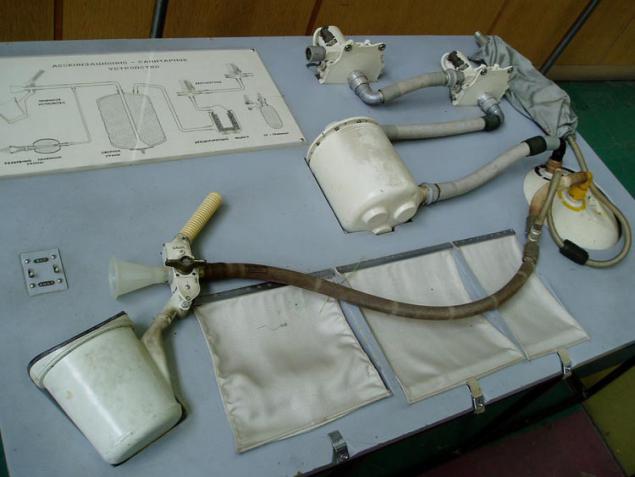
Here you can see a demonstration of work in zero gravity toilet ("Soyuz TMA-14", 2009):
Toilets Soviet space station ISS and work on the same principle as a vacuum cleaner and differ only in full seat and a complex system of liquid waste treatment. Spongy filler has a relatively small resource, so orbital stations liquid waste are in special tanks (which are then loaded with other debris into the cargo ship "Progress" and burned in the atmosphere with it), or to the recovery system which receives from the drinking water or urine oxygen for respiration.
ISS two toilets domestic production:

left the toilet in the module "Zvezda", right - in module Destiny i>
Video from the movie "Space Odyssey, Century XXI» (WC with 4:30):
Toilets sometimes broken (like any other technique) and make the news, but in fact it is very reliable and convenient device.
Two weeks in the trash h4> Unlike the designers of the USSR / Russia, the US design ideas in the cesspool issues have come a long and difficult road, and despite all efforts, to create complex, uncomfortable and unpleasant device. Ships "Gemini" had to fly long, up to two weeks, and there is already ersatz form of UCD was not enough. Strictly speaking, UCD have not gone away and used to "Gemini", "Apollo" and "Space Shuttle" at the start. Astronauts were male condom selection procedure to UCD (I recommend reading Mike Malleyna "Riding on rockets," he describes her very colorful) and could choose to start with UCD or diapers (Malleyn advises choosing UCD, diaper inconvenient). However, already in orbit had to use some more long-term toilet.

UCD since "Gemini» i>
The original design required that the astronaut peed in the bag at the same time manually creating traction, stretching accordion receiving device:

left the bag, right accordion receiving device i>
The idea turned out to be useless. First, pull the accordion alone was unreal, the second astronaut needed help. Second, the system is often threw urine instead of suction - not a fan of the accordion, one careless movement was enough to pressurize rather than vacuum.
Starting with "Gemini-V» system changed - the bag made to wear tight-fitting and as a condom. In added hose check valve, which protects against the emission of urine, and replaced the receiver unit to a simple soft Capacity:

As such, the system was more or less suitable for use. Starting with "Gemini" urine (except for small packages for further medical analysis) is not stored on board and discharged through a special valve heated (fluid in the vacuum immediately evaporates and turns to ice, without heating valve would zabilo). According to the stories of astronauts, one of the most beautiful sights in space - reset urine at sunset. Urine turns to ice and ice clouds flew beautifully. Basically, instead of urine would fit any other liquid, but plain water, for example, not dumped overboard.
With the solid waste situation was much, much worse. For them, at NASA came up with special packages:

The package had a sticky neck and had to adhere to the buttocks around the anus. After defecation had to stick his fingers in a special pouch to separate the feces from the body and push them further into the bag, so as not to have taken off. Then it was necessary to break the package with a disinfectant, to place it in a large package and faeces mix - it was necessary to kill bacteria and prevent gas formation in the package. Then came the turn of toilet paper and wet wipes, and finally had to put it all in another bag and pack it in the trash.
The whole idea was really terrible. Glue on the neck pull out the hairs on the skin, feces come out of the package to go to the bathroom it took us about 45 minutes, and there was no way not to fill the cabin odors.
The program "Gemini" was two long flight - "Gemini-V» (about 8 days) and "Gemini-VII» (two weeks). Both flight demanded uncommon willpower by astronauts. Worst of all had to Frank Borman and Jim Lovell on the "Gemini-VII». A week later, the cabin was filled with the stench of urine (not all could wipe) and unwashed bodies (there was no change of clothes or the chance to wash). Astronauts have suffered as they could - for the first time in large gatherings only on the tenth day. And the last few days became really unpleasant. But at that time it was a great victory - the United States overtook the Soviet Union for the duration of flights, and two weeks enough to fly to the moon.
On the Moon with bags of feces h4> The "Apollo" was based on the operating time cesspool "Gemini". Liquid waste is collected in the same Wear receivers with container and overboard discharge. For each astronaut was stored in 10 removable sleeves for urinal.

And with a great need was all just as bad - bags of feces remained virtually unchanged:

Decryption negotiations astronauts regularly include discussion of "Whose turd flying around the cabin»:

Because the program "Apollo" was intended to land on the moon, had to add a system for the collection of urine and feces for spacesuits. Urine was collected in a conventional UCD, and feces did something like diapers:

The peculiarity of the American space program was a detailed analysis of waste - urine and feces were brought back to Earth, and it is rumored that they are still stored somewhere in refrigerators NASA.
A giant leap forward "Skylab» h4> Only at the station "Skylab" Americans approached the Soviet level of comfort dressing. In feces disposal system finally have a fan. However, instead of the funnel used urinal cuff same as in "Apollo", but at least the fan is to create negative pressure suction of urine. But in the case of solid waste collection appeared toilet with removable bags:


At the level of the knee seen receiver for solid waste i>
And setback shuttle h4> But with toilet Space Shuttle The engineering embarrassment. The original idea was great - let's make a toilet in which air flows will put themselves in the feces receiving device without the astronaut. However, to achieve reliable operation failed - feces constantly touched the wall of the tunnel, and the astronauts had to keep it clean. The packaging system may not work reliably feces, toilet fairly regularly fails. Also, for using the toilet had to undergo special training. Simulator in the tunnel was illuminated camera. In the face of an astronaut standing monitor with an eye. Training was to put your ass in the center of the sight and remember the position of the body that is already in weightlessness feces began their journey as close as possible to the center of the tunnel. Relative to previous American space toilet system was progressive, fan and replaceable nozzles allowed to use the toilet for men and women. But the toilet was way too complicated and not sufficiently reliable. According to his astronaut Mike Malleyna before using the toilet was best to undress completely. Leakage of urine and faeces were flying away not so rare thing. Malleyn one remembers quite unappetizing joke, had pitched his fellow astronaut. He took a sausage from lunch, put it in his pocket and went to the toilet. After waiting some time, he threw a sausage in a general compartment and began chasing her with a napkin (the astronauts as they could dodged without knowing sausage flying objects) and caught up, ate ...

Toilet Space Shuttle. In the foreground is a flexible hose urinal i>
Video Space Shuttle simulator toilet. In the film, Mike Massimino is involved, which "flew" to the ISS with Howard in "The Big Bang Theory»:
Low reliability of the shuttle toilet meant that there was always waiting in the wings packages feces times "Apollo." And one can only hope that these unpleasant cesspoolage archaisms completely disappeared from the scene and did not go into space "Orion" and other new American ships.
List of references h4>
Roach, Mary "Other Side of Space." The entire book is devoted to food, toilets, washing, physical and psychological overload and other maloappetitnym but interesting hidden side of space exploration. Malleyn, Mike "Riding on rockets: outrageous stories shuttle astronaut». http://www.nss.org/settlement/nasa/CoEvolutionBook/SPACE.HTML. SP-368 Biomedical Results of Apollo . Санитарно-гигиеническое Equipment for space probes . A Review of Spacecraft Waste-management Systems , NASA, 1969 г.Previous publication series "Ensuring long-term space flight" - there are about food and closed life-support systems.
small ads h4> March 15 at 16:00 at the First Urban History Library in Moscow held my skype-lecture "Space stories." Meeting VC .
Poster 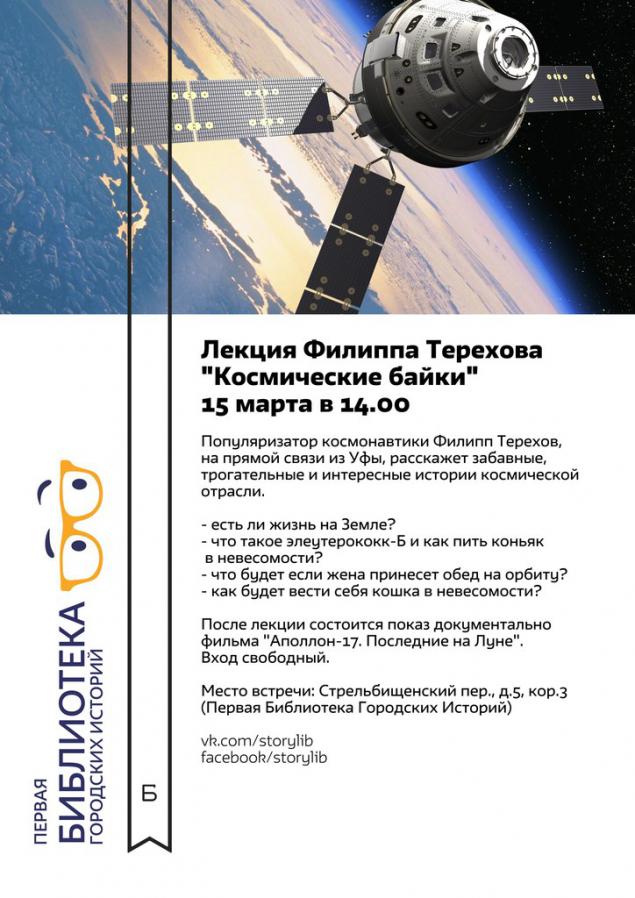
Source: geektimes.ru/post/246952/
The new technology of production of solar panels
Marcus «Notch» Persson using Twitter sold its stake in Minecraft
























